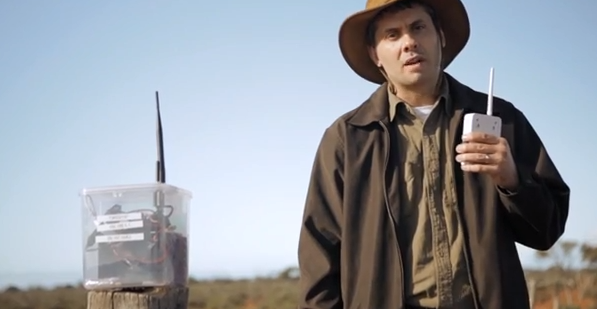A Crowdfunding Campaign to Set Smartphones Free From Cellular Networks
The Serval project, whose free software can enable smartphones to make calls and send messages without a cellular network, is appealing for help developing a home router-like device that could make its novel approach more practical. A crowdfunding campaign aims to raise $300,000 to support development of the Mesh Extender, as it is called, which helps the ad-hoc, localized networks Serval creates to extend over larger distances. Potentially just as important, the device also makes it possible for nearby phones to join a mesh network without being modified to sidestep default restrictions on Wi-Fi networking in Google’s mobile operating system. The current prototype is pictured at left in the image above, while the Serval project’s founder, Paul Gardner-Stephen, holds a mockup of a more refined version.

The free app for Android phones developed by Serval has nearby phones link up to one another using Wi-Fi, creating a “mesh” network in which every device can act as a stepping stone to help data travel between any other (see “Build Your Own Internet”). Such networks could be very valuable in places with poor infrastructure, after a disaster, or in face of government surveillance. But a phone can’t make a Wi-Fi connection longer than about 100 meters with a clear line of sight, and such a link can typically only reach an adjacent building in an urban area.
The Mesh Extender the new campaign is raising funds for can make both local Wi-Fi links and links several kilometers long, thanks to an additional radio that uses a part of spectrum typically frequented by cordless phones and garage door openers. Once turned on, a Mesh Extender can link nearby phones into a mesh network via Wi-Fi, and then connect those devices to any others linked to any other Mesh Extenders within range of its second radio. The current Mesh Extender design can be legally used in the U.S., Canada, Australia, and New Zealand. Prototypes have been tested in places as varied as the Australian outback and the National Mall in Washington, D.C. The new campaign will fund development of a more refined version that could be sold online, and for early units to be sent to humanitarian organisations for testing in the kind if environments Serval is designed to help out in.
Another feature of the Mesh Extender that may be more of interest to some is that it allows Android devices to join a Serval mesh network over Wi-Fi without being modified, or “rooted,” to turn off default restrictions on that type of Wi-Fi networking. Buying and switching on just one Mesh Extender could allow a school, hacker club, or other group to easily experiment with mesh networking.
Keep Reading
Most Popular
Large language models can do jaw-dropping things. But nobody knows exactly why.
And that's a problem. Figuring it out is one of the biggest scientific puzzles of our time and a crucial step towards controlling more powerful future models.
How scientists traced a mysterious covid case back to six toilets
When wastewater surveillance turns into a hunt for a single infected individual, the ethics get tricky.
The problem with plug-in hybrids? Their drivers.
Plug-in hybrids are often sold as a transition to EVs, but new data from Europe shows we’re still underestimating the emissions they produce.
Stay connected
Get the latest updates from
MIT Technology Review
Discover special offers, top stories, upcoming events, and more.